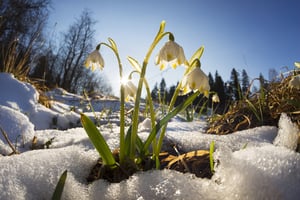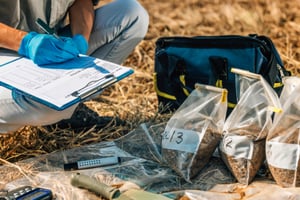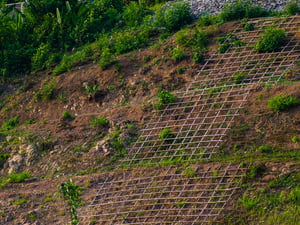Dormant Seeding Provides a Great Option for Fall Ground Stabilization
- Home
- Team EJP Blog
- Dormant Seeding Provides a Great Option for Fall Ground Stabilization
- Oct 5, 2020 4:09:22 PM
- Everett J. Prescott
As the winter months approach, contractors and site owners get serious about preparing their sites for the worst that nature has to offer. Especially in northern regions, open construction areas can expect repeated freeze and thaw cycles, along with storm events that can include sleet, snow and rain.
 For jobsites that are ready for seeding and turf establishment, early fall is the ideal time to establish a healthy stand of vegetation. This period, roughly from mid-August to mid-October, is often referred to as the seeding window. For many reasons, early fall is the ideal time to establish turf and to prepare the site for the unpredictable rigors of winter weather.
For jobsites that are ready for seeding and turf establishment, early fall is the ideal time to establish a healthy stand of vegetation. This period, roughly from mid-August to mid-October, is often referred to as the seeding window. For many reasons, early fall is the ideal time to establish turf and to prepare the site for the unpredictable rigors of winter weather.
During this period, many options are available for turf establishment. These include the use of sod, seeding and mulching, and seed protected by loose mulch, erosion control blankets or sprayed on mulches. For virtually all commercial landscapers, early fall is truly peak season.
As the weather cools and late fall approaches, turf establishment becomes more problematic. Sod farms begin to close down. Even if sod is available, installers run an increasing risk of failure. For sod to take root, below freezing weather is required, and watering is often required.
Additionally, as the seeding window closes, and the ground begins to cool down, seed simply will not germinate. At that point the opportunity for producing healthy new turf has disappeared.
 Dormant seeding is the ideal solution for ground stabilization after the seeding window has passed. While this technique has been employed for decades, the recent evolution of temporary erosion control blankets and hydraulically applied mulches has significantly increased its practical use.
Dormant seeding is the ideal solution for ground stabilization after the seeding window has passed. While this technique has been employed for decades, the recent evolution of temporary erosion control blankets and hydraulically applied mulches has significantly increased its practical use.
The dormant seeding process assumes that germination of the seed will not occur until spring. After the seed application, the prepared seedbed is then covered by the appropriate protective cover. For example, if the area to be covered is a sloping area, the installation of temporary erosion control blankets over the seed will provide erosion protection for the slope all winter long. This eliminates the need for temporary protection measures that are much more expensive to install and difficult to maintain. Those tools could include silt fence, erosion control berms, straw wattles or compost filter socks.
Overall, the ideal time for dormant seeding is when the ground is not yet frozen, but cold enough that seed will not germinate until warm weather returns. Seasons vary of course, but in northern climates this period will usually include November and possibly early December.
It is important to note that all seeding, regardless of the season, should begin with a soil test. A soil test will help the installer make the right choices regarding seed mixtures and soil amendments. This crucial step is often omitted, yet common sense will tell us that the best results will occur when appropriate seed mixtures and appropriate fertilizers and soil additives are applied.
 Soil tests are free of charge, and free of obligation. Owner and contractors simply need to bring soil samples to any Team EJP location. The sample can be provided in a small box or a to-go cup, and they will be submitted for analysis. After the soil is tested, submitters will receive a thorough report. The test results will provide a thorough set of recommendations to the end user, including seed mixtures, recommended additives and fertilizers, and appropriate seed bed protection.
Soil tests are free of charge, and free of obligation. Owner and contractors simply need to bring soil samples to any Team EJP location. The sample can be provided in a small box or a to-go cup, and they will be submitted for analysis. After the soil is tested, submitters will receive a thorough report. The test results will provide a thorough set of recommendations to the end user, including seed mixtures, recommended additives and fertilizers, and appropriate seed bed protection.
Preparing a seedbed for dormant seeding follows the same fundamentals as required in all seeding seasons. Most crucial is solid contact between seed and soil. To assure this, the seed bed must be clean. This requires that any loose mulch material or existing vegetation must be thoroughly removed before seed application. For example, erosion control blankets installed over vegetated areas will be pushed up or “tented” by the vegetation, causing loss of critical soil contact. The seed must also be raked into the soil. Whether hand raking or using a power rake, it is ideal to penetrate into the top quarter inch of the soil surface.
 Many options are available for protecting a dormant seeded area. Team EJP professionals, consulting with our vendor partners as needed, can assist in helping make the right choices. For example, protecting a very steep slope will require a very aggressive protection solution in contrast to a flatter area.
Many options are available for protecting a dormant seeded area. Team EJP professionals, consulting with our vendor partners as needed, can assist in helping make the right choices. For example, protecting a very steep slope will require a very aggressive protection solution in contrast to a flatter area.
Once all these steps have been taken, owners and installers can rest assured that their sites are well protected for whatever set of challenges the winter months bring.
As spring arrives, germination of the seed will occur. This process is not always perfect. Often, certain areas will fail to germinate. In these cases, overseeding will be necessary. On the plus side, a carefully planned dormant seeding program provides a sound and proven tool for winter jobsite protection.
In the months to come, Team EJP will continue to offer available tools for use in the important business of managing our precious soil and water resources. Contact Team EJP today if you have any questions!








